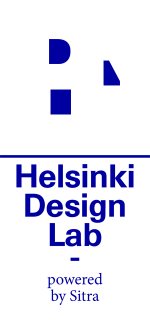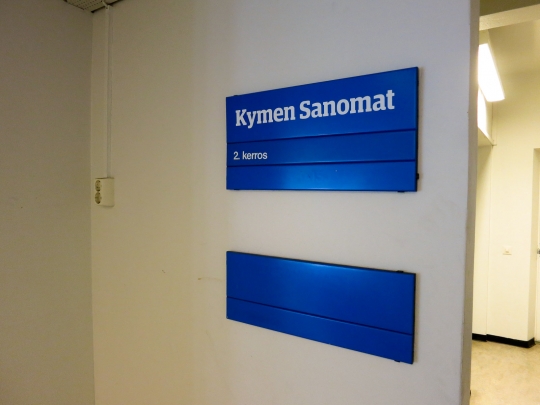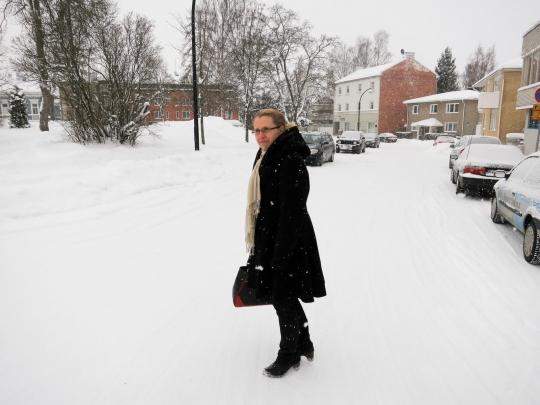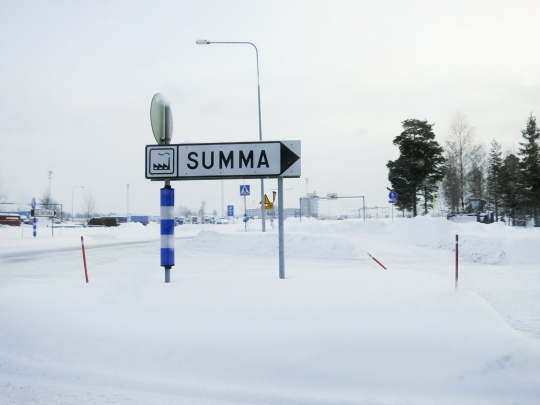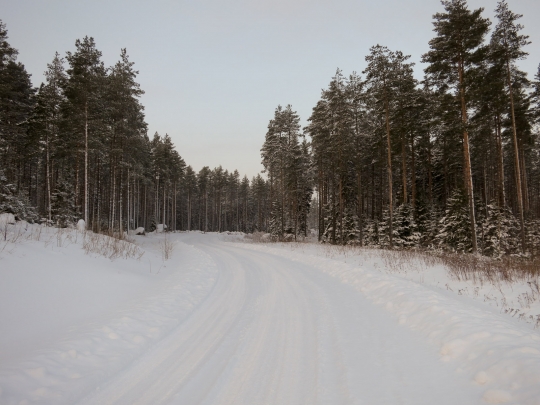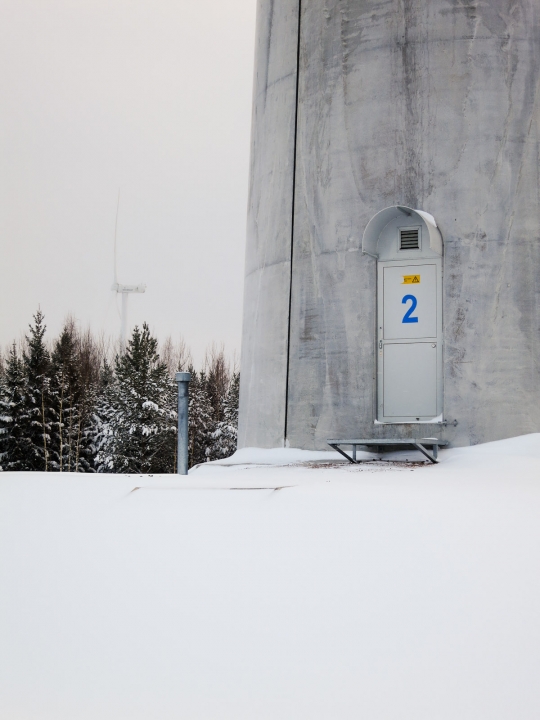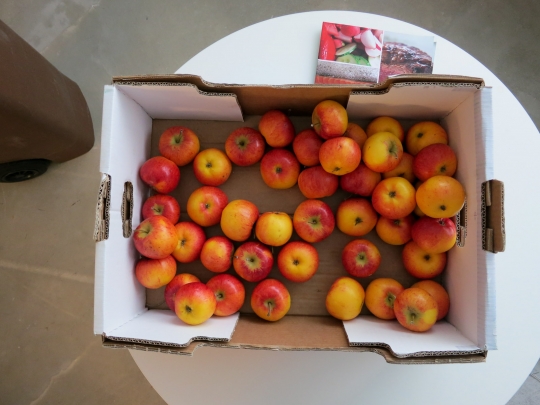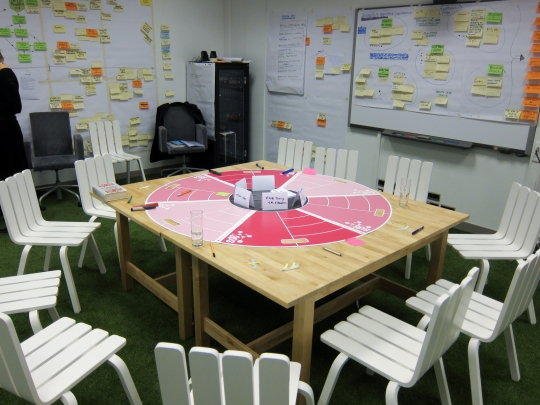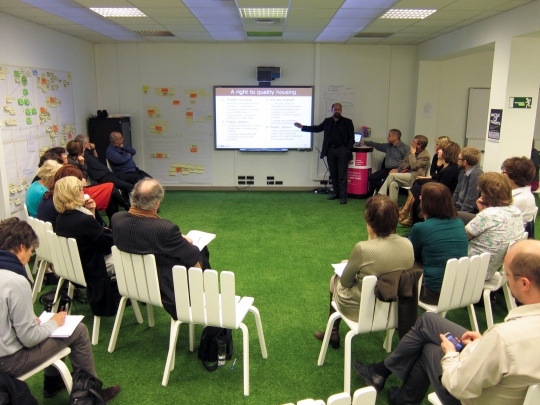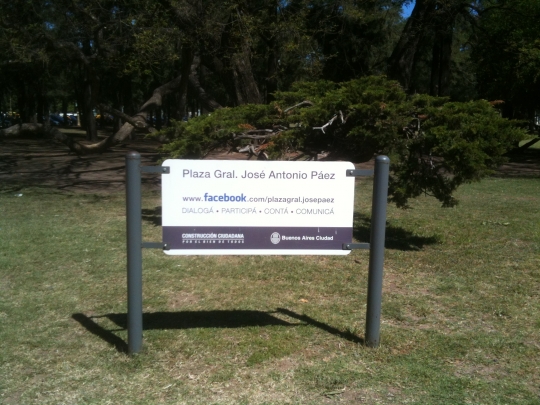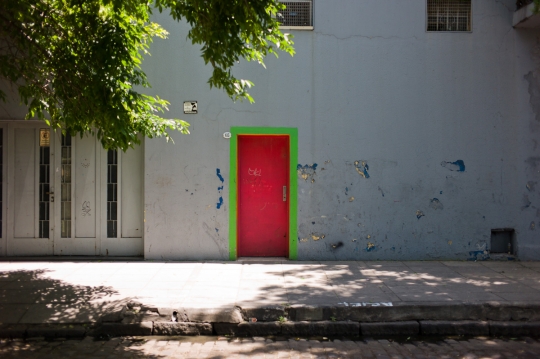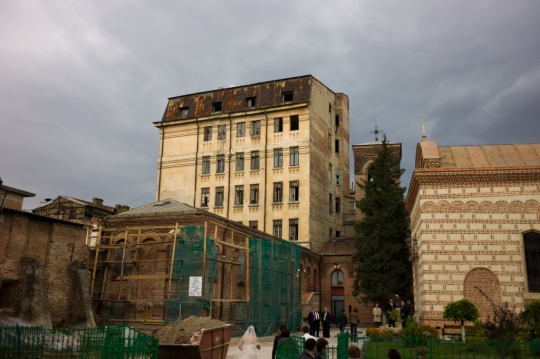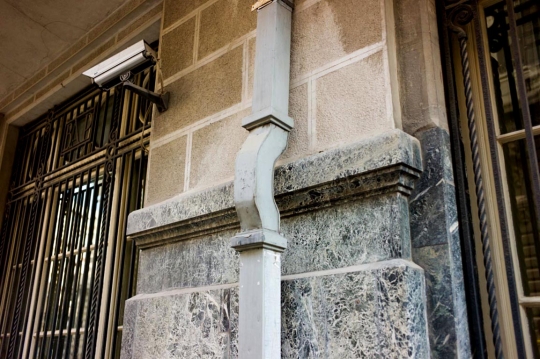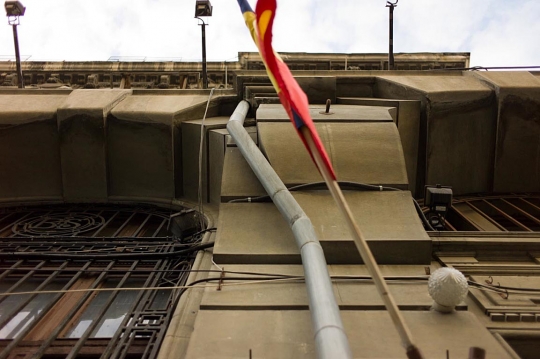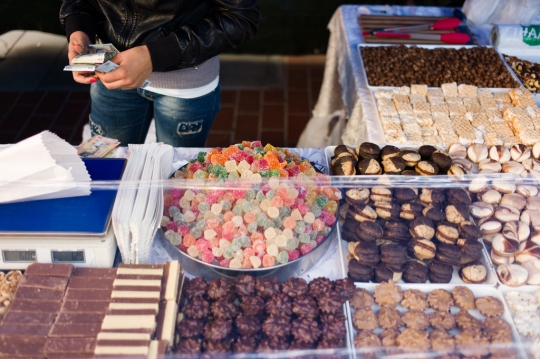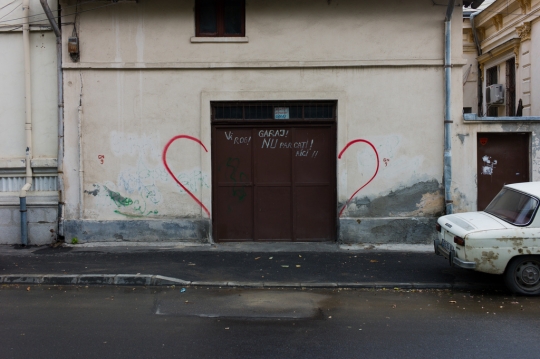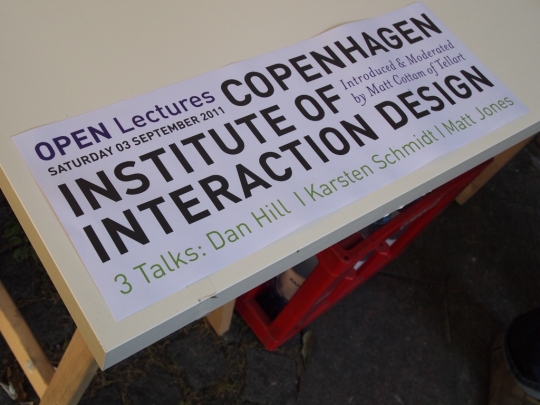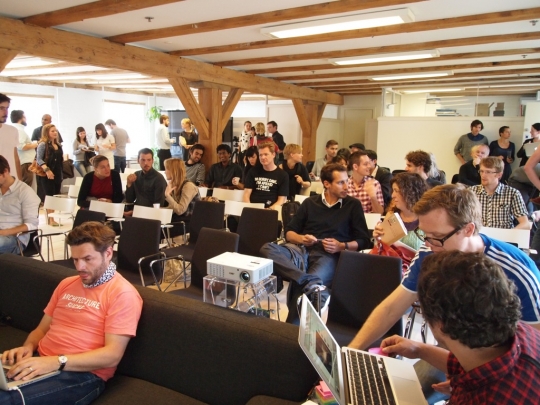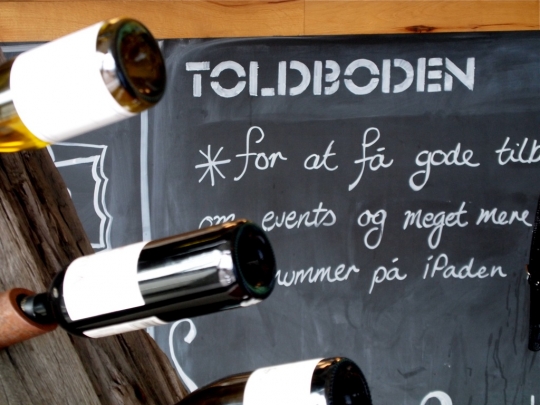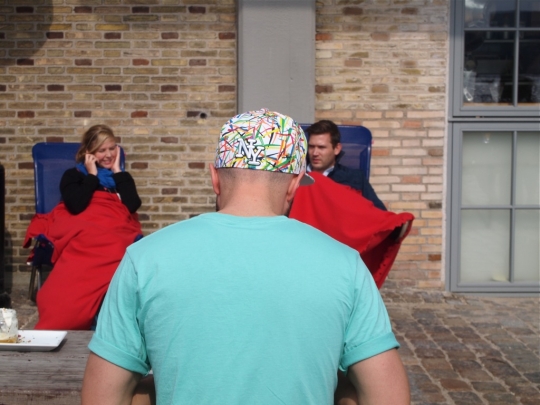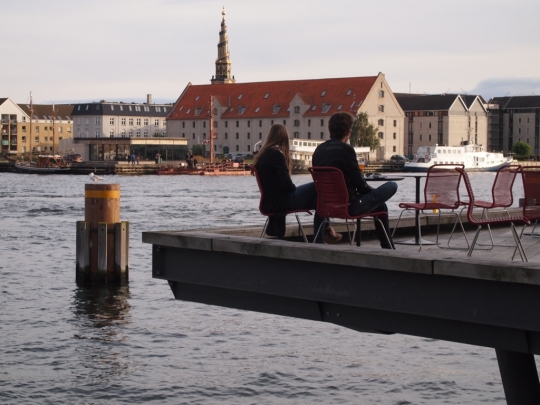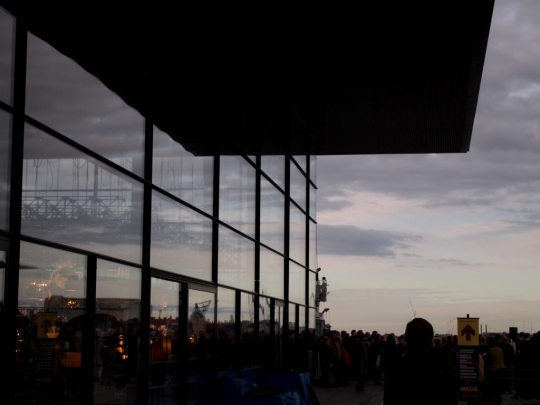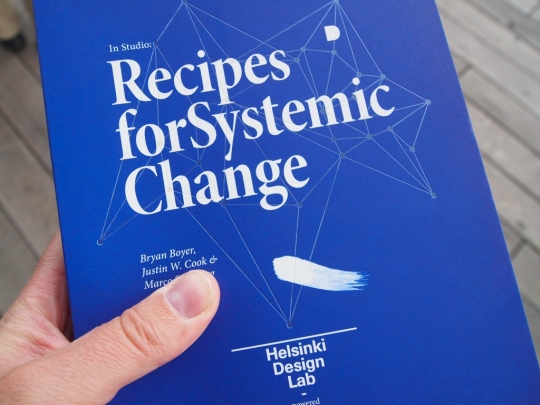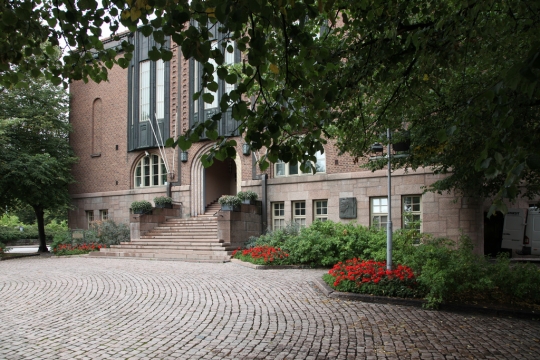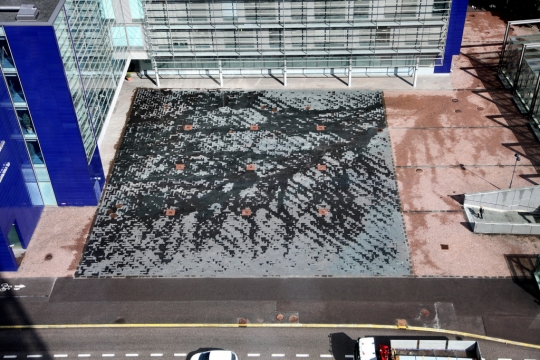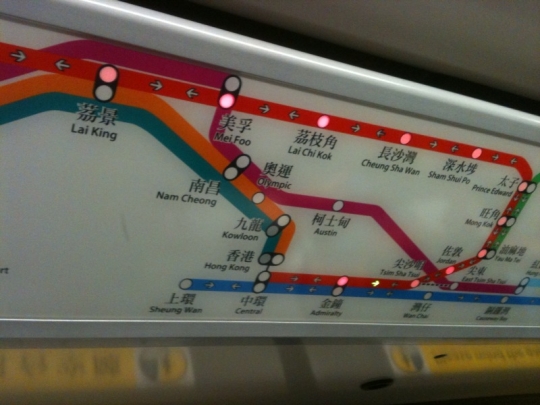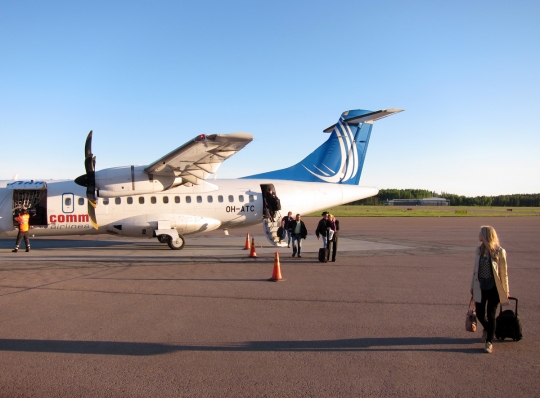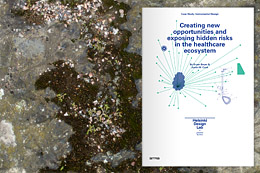All posts tagged Travels
Three polite words that begin with F: frozen (temperatures), and freedom (from fossil fuels), and food. Let's see how these unpack.
Now that winter has set in, we are regularly experiencing temperatures in the range of -10º celsius. This makes for treacherous sidewalks but otherwise adds lots to the quality of life in the city: cross country skiing, sledding, new things on the ice, and plenty of light reflecting off the snow.
Recently Dan, our colleague Karoliina, Nina the intrepid interpreter, and myself spent a day in Hamina where it was also very frozen. Located 1.5 hours east of Helsinki, Hamina used to have two industries: a port and the paper mill but the later closed down in 2008.
Luckily for them, the mill premises found a new tenant who values cheap energy and the location's essentially limitless supply of cool Baltic water: Google purchased the property in 2009 and set up a data centre shortly thereafter.
Although the Google story is interesting, it's not the core of why we went to Hamina. We were there to learn about the way that the city has successfully fostered green energy, both as an energy source and as an industry. Early indicators point to Hamina as a positive example of how a community de-industralizes itself with as little long-term pain as possible. They paid attention to larger structural changes in Finland's economy and reacted decisively to find a new way forward. Google's data centre was one positive outcome, and the other is WinWind who manufacture wind turbines. In parallel with these new developments in the local economy, Hamina's municipally owned energy company also courageously set up a modest wind farm.
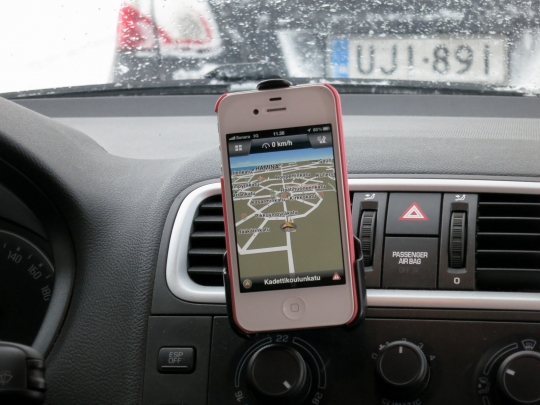
Hamina is known for having a circular town center
We wanted to understand how this happened. How does a community make decisions about its future? Or in other terms: how do communities make shared decisions from a shared value perspective?
Shared decisions are those which are bigger than any one person. Things like building a new road or rail, cordoning off a nature reserve, or passing a law. And shared value is measured in financial as well as social and ecological capital. Although the term is borrowed most recently from Michael Porter, the basic concept is by now quite generic—you might even argue that figuring out shared value is the challenge which underlays all others.
Our trip to Hamina was the first bit of research into this. How did they get the idea to build a wind farm? And how did it get negotiated in real space, with real euros, real local politics, and real personal opinions? How did Hamina decide to open its port area to new industries? How did Hamina propose for itself a new future?
In the coming weeks and months we'll be visiting other communities that have made—or failed to make—shared decisions as we try to better understand how we might help these processes flow more easily and productively.
One of the areas of focus is a phenomena called Not In My Back Yard (NIMBY) and how we might crack open more opportunity for Please In My Back Yard. In essence, we're interested in how communities balance the right to express negative opinions with the civic obligation of participation in the public realm, in local economies, in politics, in society. So how do we make it more meaningful and easier for people to engage in shared decisions? That's what we'll be focusing on in the area of work we've been calling Brickstarter internally.
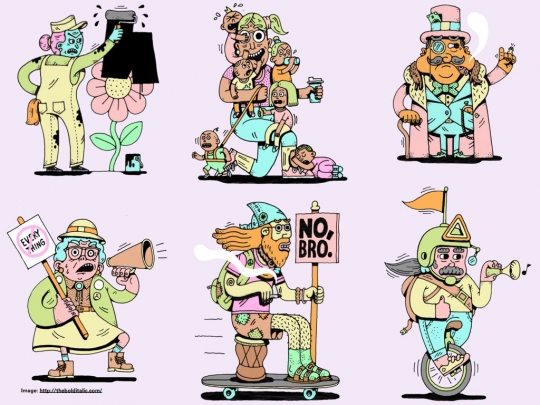
A collection of NIMBY archetypes by Miquel Hudin drawn by Loren Purcell
Justin, Marco, and Johanna spent most of Friday in Lahti working with the city planning department there as part of our Design Exchange Programme. Things there are off to a good start with an ambitious timeline. We are also working on a new website for the exhange participants to share their experiences regularly.
Internally at Sitra we continue apace with work on tools, systems, working culture, and spatial resources. The first three involve lots of meetings in conference rooms, the latter involved one meeting in a design studio. It's also worth noting that there's a new Sitra.fi website!
Dan was over in London this weekend giving a presentation at The Design of Understanding. It's a safe bet that you can expect a write-up of some 10,000± words from him in the nearish future.
As always, an update on the food work. We spent a bit of time in Tukkutori with Elina and Ville, sharing notes on what we're up to and the same from them. Tukkutori is Helsinki's wholesale market and will be opening to consumers in the fall. Lots of exciting stuff planned there and we're seeing how we might be invovled, particularly with an eye towards strengthening the pathways for good ideas to grow up to be good businesses and good regulations and policy.

You never know what you're going to find in Tukkutori
And yes, some mockups for print. The food booklet we're working on may or may not come with a poster.
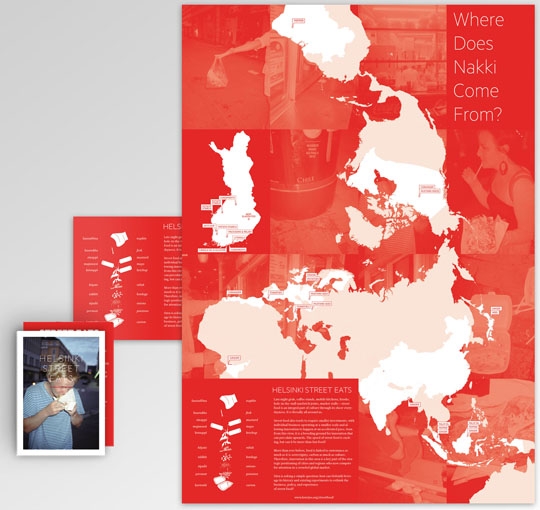
As I write this post there's a bubbling hive of activity behind me inside the Flanders District of Creativity in Leuven, Belgium. I've come to sit in the back of the room while the government of Flanders hosts a studio on child poverty. But more on that soon. This is the culmination of a particularly hectic week with two book launches in the US, some fast-paced work on a handful of projects in Helsinki, and now Belgium.
Let's start in New York. Justin, Marco and I were pleased to host a launch party for In Studio with Amb. Ritva Jolkkonen, currently the Consul General of Finland in New York. She very kindly welcomed a group of designers, NGOs, and public sector people for a gathering at her residence which features a rather stunning view over central park. Naturally, this is the one time (seemingly) when I did not have a camera on me. You will have to imagine the view.
On Tuesday Marco spent the morning presenting at and moderating a discussion for an event hosted by MIT's Collaborative Initiatives. I wasn't in the room, but from what I hear he did a bang-up job keeping a group of big-wigs on track.
Just to make sure we're not being lazy, we also hosted a book launch in Cambridge, MA that evening, seeing as we were already in the neighborhood. Turnout there was good and it was nice to see some familiar faces.
Back in Helsinki, I had a brief meeting with the Helsinki Ympäristökeskus (Environment Center) relating to our ongoing street food work and Dan and I had the pleasure of meeting Stuart MacDonald. Stuart was in town from Glasgow for an event hosted by the British Council. He alerted us to some of the strategic design work that is bubbling up in the UK, particularly around community planning. We'll be digging into that more in the future as Brickstarter ramps up.
Oh right, Brickstarter is ramping up.
Speaking of the UK, Dan was in London for something less than 24 hours to participate in a meeting of the minds that attempted to merge neuroscience with... urban planning!
Amidst all of this Aalto University reversed an earlier decision about the name of the school which contains the departments of art, design, and architecture. Previously they had announced that it would be called the School of Arts and Creativity, but after significant public uproar it will now be called the School of Art, Design, and Architecture. Personally I see this as very positive. Claiming 'creativity' as a namesake was not only a little greedy, but also rather devaluing of the disciplines that the school represents.
The studio here in Leuven is getting ready to make their final presentation so I will hastily close this weeknote and leave the details of what's happening here for the next post.
First, a note from one of Sitra's other projects called Reviving Village Within A Town. In an effort to enable young people to have a more active role in co-designing the services that are available to them (like sports programmes), and therefore also getting more out of these services, we find two intertwined lessons. One about time and one about scale.
“People are active themselves instead of waiting for others to do things on their behalf. After all, local well-being is built on the people’s own initiative and activity,” [project manager] Mira Sillanpää points out. “You must also remember that it is not always about creating all-embracing solutions for the long term. Small changes can also have a huge impact. If the needs of the local residents change, the services provided by local authorities must change accordingly.”
In Mira's observations as quoted above, there are familiar tones of the ethos of prototyping, of beta, and of iteration. But perhaps more profound is what she gets to at the end: that times change, needs change, and that our public services should be similarly agile. In other words, being able to end programmes gracefully is as important as starting them intelligently.
And this ties to another aspect of the project which is embeded in the very name of the work: Reviving Village Within a Town. Lurking here is a recognition that scale matters too. The project is located in Hämeenlinna, a town that includes a number of smaller villages. By making room for local communities to conduct low-risk experiments in their own areas, we gain the ability to test and iterate at a more manageable scale before growing or replicating what works to other communities.
In other words, early innovations are not for everyone, and not for everywhere. Utilizing the small scale—in both time and space—allows us to be more sophisticated about our risk assessments. More of this please.
Twelve thousand kilometers away, in sunny Buenos Aires, the government there is also thinking about the power of the small scale, albeit in different ways. While in Argentina to give a talk as part of the CMD international design conference, I noticed that some of the parks have signs which implore residents to visit a Facebook page like this one. One finds a brief bit of history about the place, an invitation to share stories, participate in events, and to use the public space to organize your own functions. Smart, simple, cheap.
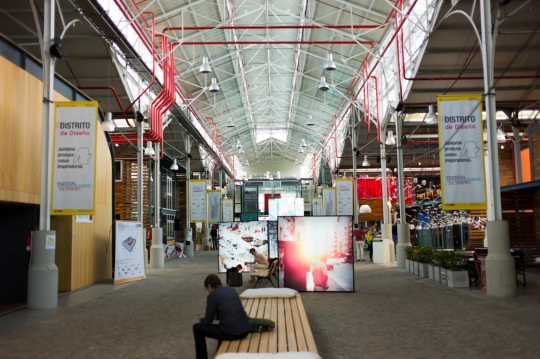
CMD is housed in a large building that used to be a fish market. It's vast!
But to CMD, the main point of the trip. The Centro Metropolitano de Diseño is a facility sponsored by the city government of Buenos Aires in an attempt to boost the creative industries. It's a bit similar to the the Design Forum here in Helsinki, except CMD also includes incubation space for young design-led companies. Under the ambitious leadership of Enrique Avogadro, CMD are expanding their focus to look at the potential for design-related business and programmes that are able to generate social capital in addition to financial capital. Being located next to one of Buenos Aires' villas provides extra imperative. This is the context in which I was there to share Sitra's work on strategic design, and particularly what it means to practice design in a public sector context.
Back here in Helsinki, as we continue to develop our work on the mysterious exchange project, we've been looking at things like this Bloomberg Innovation Delivery Fellowship. And then for no particular reason other than the fact that we saw it from a couple different people on twitter, also MIT's Atlas of Economic Complexity.
Dan spent a couple days in Sigtuna, Sweden where he was part of an international workshop hosted by MISTRA, The Foundation for Strategic Environmental Research, who are undertaking an ongoing indea development programme to identify new areas of research. After that he and I were consolidating thoughts on some small renovations to the Sitra tower.
Marco was in Finland but in and out of the office, including giving a talk at a Fortum event as well as taking part of the ongoing World Design Capital public sector working group.
Justin took a day trip from Boston down to New York to meet with the consulate there and begin preparations for an upcoming book launch later this month. He's also taking care of logistics for a launch in Boston, so if you're interested in either of these, check back in a week or so for further details.
And daylight savings time happened, so it's officially dark here. This was week 137.
If you look closely, you’ll see many of the rooftops of Bucharests’ Lipscani quarter glimmer in the sun, reflecting newly applied copper and tin back to the sky above as if to suggest that first and foremost this metropolis is rebuilding itself under the eyes of god. While this city is indeed dotted with its fair share of sites bearing religious importance, there’s no mistaking the zeal with which modern Bucharest is being rebuilt by the people on the ground. It’s a place where one encounters making and re-making almost at every turn and it's a great coincidence that the neighborhood at the forefront of this change is one with a long history of trades and guilds. Romania is not waiting for any heavenly bodies to anoint them, if the organizers of Connection have anything to say about it the focus here is on linking up the market and the citizenry into a society that is sustaining and sustainable. I’ve come here to keynote Connection, a conference on social innovation put on by an ambitious group called Ropot. More on this in a bit, but first: the city.
Lipscani plays the part of a familiar European tourist district, replete with terraces sponsored by beer companies, street vendors, and the steady thump-thump of Euro beats oozing out of cafes with more neon than customers. On the surface it can be generic, but with a closer look one finds moments of genuine and endearing locality. Many of the wares on offer at the street market, for instance, appear locally produced and this includes the sweets (which are very sweet). Pockets of the 19th century, such as the popular brewery restaurant Caru' cu Bere offer a hospitable glimpse of the pre-communist city, not to mention a hearty meal to beat back the chill of an autumn Sunday.
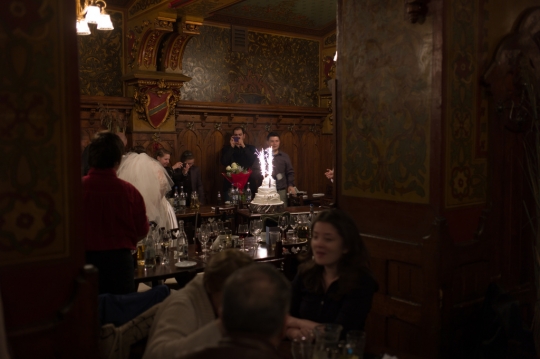
A local wedding amidst the tourists that fill Caru' cu Bere to the rafters
According to locals, the original dream of the reinvigoration of this neighborhood was to create an artists’ quarter. Although the current iteration is more gentrified than this—and it’s no Postdamer Platz, so this gentrification is very relative—gems like the small bar Atelier Mecanic shine through. It’s a sort of high style junkyard where the local cool kids drink amidst a setting various mechanical trinkets repurposed as thoughtful decoration. The communist-era leftovers lining the walls are strong material symbols and it’s tempting to see them as trophies of the conquest, now drained of their robotic animation and relegated to watch from their perch on the walls as contemporary Bucharest thrives. It’s the kind of place where one imagines a new generation of intelligentsia congregating, like the editorial staff of Decat o Revista, an upcoming local magazine on the model of “Wired meets the New Yorker”, or the group of architecture students sketching across a narrow table while I visited.

Sunday afternoon in Atelier Mecanic
But one does not come to Romania without thinking about Dracula, and so to his castle we go. Three hours north of Bucharest is the town of Bran, the population of which has just grown by 80 for Connection, a long weekend focused on building social innovation capacity within central eastern Europe. Initiated by the enthusiastic four-person core of Ropot and executed with a network of partners, the event brings together a wide range of people from Romania and neighboring countries to bring new ideas to the conversation. Carefully crafted as a multi-day event, it’s also designed to build connections and spread knowledge laterally.
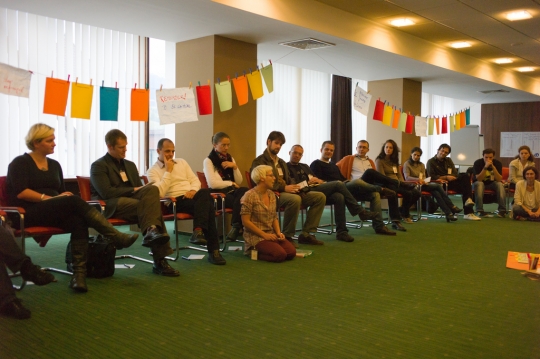
Don't let the looks fool you, although the atmosphere was decidedly relaxed, Connection was carefully orchestrated
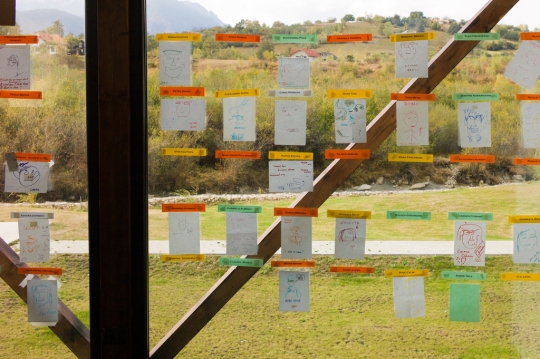
Blindly-drawn portraits posted as a who's-who of the event
In the spirit of the many social entrepreneurs in attendance, I came to make a simple pitch: details make or break big picture ambition, and design approaches are a useful lens to pursue the details and the big picture concurrently. Under this umbrella I took the opportunity to share Sitra’s work on projects including HDL, Synergize Finland, and Low2No. The latter containing an excellent example of the big picture/small detail balance in Sitra’s efforts to remove barriers to large scale timber construction in Finland. This is driven by the big picture goal of a carbon neutral built environment but involves to specific (but unexpected) actions such as working to change fire codes so that large scale timber construction is possible, not just for us but for others as well.
But I started my talk with a simple observation from the streets of Lipscani: we live in a world of multiple overlapping systems and yet these are all too often sub-optimized in isolation of each other. In just about any European city you can observe this for yourself in very concrete terms by paying attention to the downspouts. Often you will find that downspouts and other external plumbing takes a less than direct path to the ground, and occasionally one that involves significant conflict, such as the photo above with a drain violently puncturing through the decorative plaster work of the building. This is a visible symptom of the architect and plumber not agreeing on which system will take precedence and which will gracefully defer.
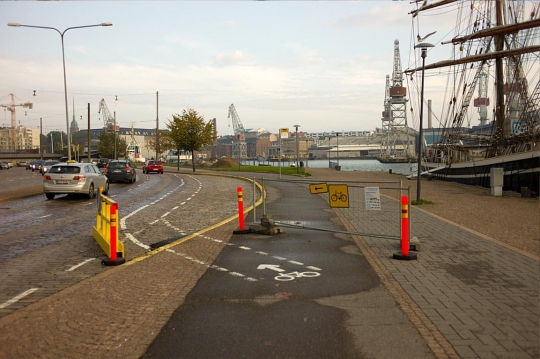
The rigidity of different systems becomes extremely apparent in moments of forced intersection
It’s an example of the impossibility of agreeing to disagree when decisions are involved. We can agree to disagree on a philosophical basis because this stays in our minds, but when it comes time to do something in a world of finite space, time, and material, action requires agreement—or violence.
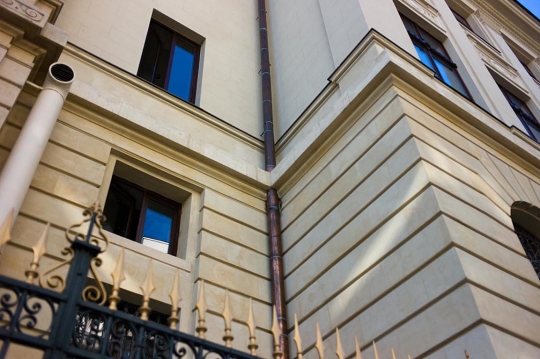
Function piercing decoration, or: the hard considerations of gravity, flow rates of water within a pipe, and the threat of water damage against the soft factors of the cultural value architectural form, symbolic meaning of a building, and connotations that a physical structure conveys onto the organization that sits within it
At the core of this observation, and my pitch that design is positioned as a lens to help us make sense of it as a practice, is the observation that we’re still often clumsy in bringing synthesis to hard and soft factors. In the example above, rain water, flow rates, gravity, etc. vs. architectural form, cultural meaning, social connotations.
To resolve these two into a harmonious whole, as one is able to observe in more considered acts of architecture, requires a synthetic approach that balances the demands of hard and soft factors. This is something that the best businesses do as well. Nokia had touch screen phones much before Apple, after all, but the technocratic approach they took to conceptualizing a phone as a gadget inhibited full consideration of the softer side of the cultural role of a cellular phone. (For what it’s worth, this is demonstrably different now that Nokia Design is under the leadership of Marko Ahtisaari).
And so one of the central aspects of the conversation at Connection was the difficulty of bringing hard economic costs and soft social benefits onto the same ledger so that an attractive investment case can be made to appropriate investors. As groups across Europe are currently struggling with this issue, I was not surprised to see the same here in Romania. What encouraged me, however, was the verve with which some of the attendees took up the challenge.
As groups which aspire to support and enhance local communities increasingly look to social investment rather than grants, an important bit of mindset change is occurring. The more we as a society are able to entertain social returns on investment the closer we are to obtaining one of the basic mechanisms of a healthy social society—one that neither forces each individual to be a self-sufficient island nor forces the state to make unrealistic promises.
Investments come with investors, and investors have a moral obligation to put their money to best use. In the past this has more often than not implied the best annual return in financial terms. Looking forward, the notion of returns will slowly become more open, perhaps also including social returns expressed in monetary equivalent in a manner similar the cap and trade of carbon emissions.
The reason why I gave up my weekend to participate in an event in the middle of Romania is because I wanted to see how this part of the world was thinking through these issues, and what I might be able to bring back with me to our work in Finland. There are a handful of leads I will be following up, but the thing that came through most clearly was the drive and commitment of the participants to devise new ways of addressing the issues they’re concerned about—be it corruption, poverty, social exclusion—with a constructive eye towards the future. Connection itself is a testament to that by virtue of the fact that it eschews the typical conference format of individual grandstanding and hands-off consumption of presentations and instead delivers a weekend of capacity building.
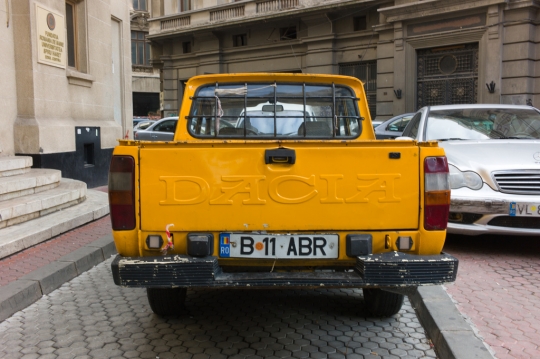
Romania's native carmaker, Dacia
We took turns sharing experiences in finding the right product, developing a business case, and what to look for in policy EU developments that will affect social innovation. But also about very pragmatic skills and tools such as learning how to hone a pitch and how to skillfully use media—both traditional and non. These how-tos were anchored by a mix of stories on the ground from individuals such as Chris Worman who is developing an innovative community ‘loyalty card’ scheme in central Romania and Dr. Anna Burtea who is exploring new commercial opportunities to enhance her foundation’s reach and impact. As examples of social innovation in development they were not all easy-breezy success, and that’s what I appreciated most. The Connection team managed to create an environment where frustration and failures were just as much a part of the conversation as success and scale.
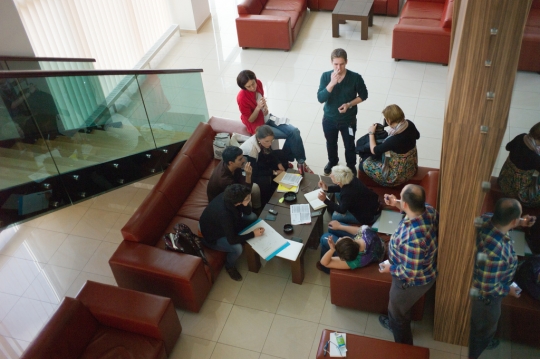
Ropot and their co-organizers take a moment to regroup and adjust plans for the next session
So when I write that I left the event feeling optimistic it’s for the same reasons that I enjoyed my brief time traveling the landscape of Romania: it’s a place that is still in the habit of making things, but equally one that can remake and repair when needed. Perhaps because of the relatively high levels of contrast visible even on the street—I did, I must confess, nearly escape a pack of angry wild dogs—I detected in my fellow attendees both a shared sense of responsibility for the future as well as an imperative to find one’s own specific contribution.
Back in Bucharest, as I type this blog post I am using a wifi network with the password “2030wifi”. An eye on the future, indeed.
Catching up, catching up. As predicted, Autumn is here and the pace is picking up. Several of us are just back from Copenhagen Design Week, where we did a number of productive things, as well as just enjoying that fine city.
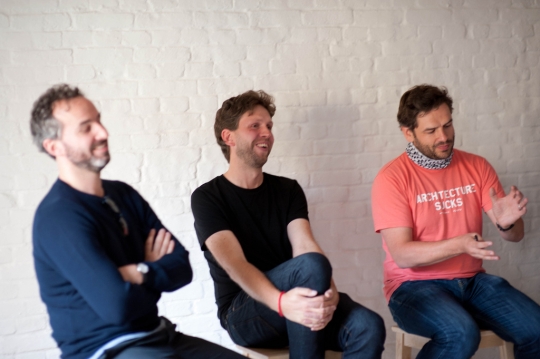
Me, Karsten Schmidt, and Matt Jones, photo courtesy of Matt Cottam.
I was there to speak at the Copenhagen Interaction Design Institute (CIID), with Matt Jones of BERG and Karsten Schmidt of PostSpectacular, organised by the great Matt Cottam (Tellart etc.) and Alie Rose (CIID). The talks from Matt and Karsten were both chock-full of challenging, brilliant thinking and as ever it was a privilege to share the bill with them.
I'll try to post some thoughts from my talk here (or there) later, but essentially it covered the shift from interaction design at the urban scale to strategic design at systemic scale, and the importance of designing both the matter (the objects, spaces, services) at the same time as the meta (the context, the organisation, the culture.)
Low2No is one of our primary examples. Here, what looks like a building project is actually a 'trojan horse' or 'hook' for a whole series of other systemic changes, around the forestry industry, smart cities, food culture, design methods, ownership models, carbon accounting, innovation environments and so on. So this was 'From Matter to Meta' and back again. There's a lot more to come here, but thanks to CIID for organizing and thanks to an attentive crowd, particularly taking the time out from a sunny Saturday afternoon.
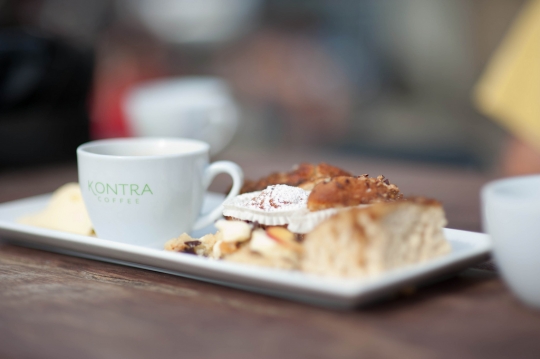
Toldboden brunch, photo courtesy of Matt Cottam.
Bryan and I joined Team CIID + BERG for Sunday brunch at Toldboden, which we suspect may be currently the best brunch place in Europe, if not the world. We understand that this is quite a claim, but still.
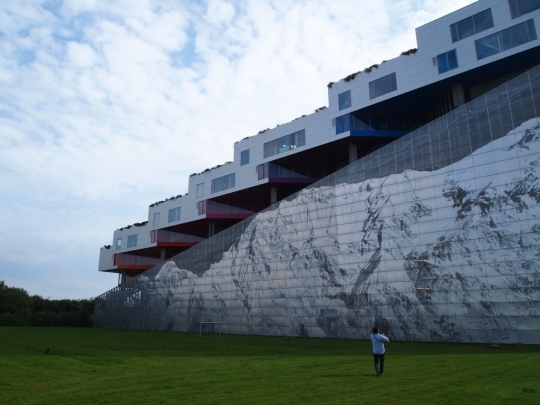
The Mountain, by Bjarke Ingels Group, Ørestad.
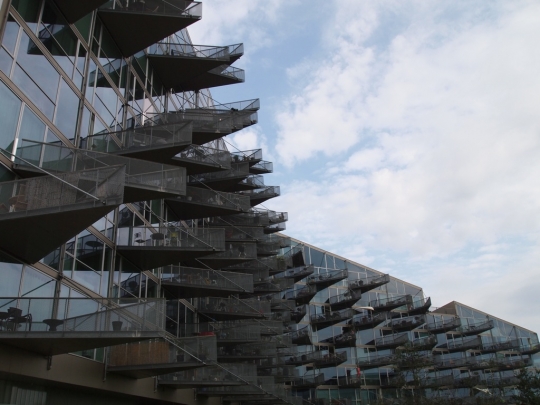
VM Buildings, by Bjarke Ingels Group, Ørestad.
Then just time for a quick excursion to Ørestad, to see a couple of fine, and by now well-known buildings by Bjarke Ingels Group (but also the fairly bereft streetscape there. Hmm.)
Bryan and Marco were in town to participate in a conference organised by our good friends MindLab. 'How Public Design? Leading Change in Government' was an international seminar featuring government, academics, design practitioners, and others. The foundations for the conversation were laid down by rich stories and case studies about existing design work within the public sector; the conversation itself often focused on how to scale this work up, and what new cultures of public sector might result, or otherwise be enabled. Thanks also to MindLab for a great event.
As well as general INDEX Award shenanigans (and congrats to one of our collaborators, Alejandro Aravena, for his firm Elemental's award there) we were also in Copenhagen to meet a consignment of The Book (around twelve copies sent to our hotel).
We finally have it in our hands. Called 'In Studio: Recipes for Systemic Change', the content unpacks the studio model and its use in terms of understanding the architecture of systemic challenges and quickly sketching out coherent, practical and imaginative visions that address such interlocking problems. Hopefully you'll find it a useful resource and a good read. Again, credit to Bryan, Justin and Marco for producing a genuinely original contribution, and particularly for Bryan for handling the production. The book looks and feels great, thanks to design by Two Points in Barcelona.There's a foreword by Geoff Mulgan of NESTA, and an afterword by our president, Mikko Kosonen. We'll post about the book separately, very shortly, including details on how to get it.
We've also been working on a dossier around design ethnography; please have a look and let us know what you think. Any comments gratefully received, particularly other references or case studies you think we should link to.
In other work, we've been working hard on Low2No, and I've been picking up two threads in particular: the 'smart systems' work (our informatics-led angles developed by Arup and Experientia) around the building, and then how our organisation develops in the context of the new building. The relationship between building projects and the organisations that inhabit them is complex and symbiotic, and as part of the client body for the block, and ultimately an occupant, we'll be using this opportunity to continue the development of Sitra the organisation too.
In terms of 'smart systems', we're trying to develop a more sophisticated understanding of what this might mean, particularly as compared to yer usual building project. On a typical project, ‘smart systems’ can essentially be seen as shorthand for 'automating everything in sight', which we feel would remove the opportunity for engagement, agency and responsibility from the various users of the building. Which doesn’t feel particularly smart to us.
So we're trying to build up a simpler but more engaged relationship between occupant and other users, building, building technology, organisation, and city. This should take advantage of contemporary thinking around smart systems and smart cities whilst preserving, even expanding, the role of people within and around the building. This is partly to do with our strategic objectives around 'sustainable well-being', and the desire to produce replicable strategies for systemic change, but also to do with creating a simpler, more effective, more enjoyable workplace.
These words might come back to haunt us—until a building is built and occupied, one never knows—but we want the exact opposite of the all-too-familiar hotel room experience in which you're searching for the impenetrable remote control required to turn on the standard lamp. Some things are not problems that need fixing.
Some are, however, and we think we're on to something new and useful with our approaches here. We'll report back on this too, as it develops, on the soon-to-be-relaunched Low2No website. (Yes, I'm aware this is turning into a series of nested links to future posts.)
In the aforementioned CIID talk, around matter and meta, one thing I touched on was redesigning the context around products, services, relationships. Or, as I put it here, "You can't design a transformative service without redesigning the organisation."
This follows the legendary Finnish architect Eliel Saarinen's quote: "Always design a thing by considering it in its next larger context - a chair in a room, a room in a house, a house in an environment, an environment in a city plan." i.e. the context is often an organisation, and so a complex net of relationships, one way or another. As I pointed out in my talk, I think you can go the other way too i.e. design the context considering the thing it is intended to produce. Again, it's symbiotic.
With this in mind, our work in terms of organisational change at Sitra is therefore part of this building project, part of this ICT procurement, and so on. Given that Low2No represents one component in another stage of development for our organisation—a Sitra v4.0 perhaps—we have also been exploring what a Sitra v3.1 or v3.2 might be (this numbering is just an example, as organisations are actually in multiple stages of development simultaneously; it also deliberately avoids using the dread word '2.0'!).
These are small-step experiments that we can do right now, iterations along the way to the new organisation in the new building. These are never binary or direct relationships i.e. the new building does not 'effect' the new organisation into life from day one, nor does a new organisation necessitate or articulate a new spatial context. It's never that simple.
So the .1, .2, .3 series of hops in effect enables the organisation to 'try on' new working methods, relationships, identities, new layouts, patterns and habits. It 'de-risks' the change implied to some extent—it makes a new building three years away into something more tangible and at-hand—whilst enabling the kind of instructive forward momentum that prototypes bring to other fields.
Not that Sitra needs redesigning, but Bryan and I did some work at our recent summer awayday in the beautiful forest around Mikkeli, helping our teams constructively imagine some new working habits, patterns and spaces. We may even be able to prototype some of these in our existing building in Ruoholahti, which helped this become more than just a paper exercise.
Oh, and I've also been writing up our research into food culture in Finland. More on that soon too!
Lots of little things, these last weeks. Perhaps this is appropriate since some of the trees around town are already starting to let go of their leaves. Increasingly, there are lots of little things all over the ground.
Justin and I have been doing a bit of work on a new website for Low2No, but it's mostly him down in the mine at the moment. I'm pitching in with advice here and there as we navigate that towards launch in early September.
Marco and Justin have been looking after the Low2No block itself, as they do in some form or another just about every single day. Justin was in Berlin meeting with our architects, Sauerbruch & Hutton, on the design of Sitra's new offices. Meanwhile Dan and I have been working in-house on the continued development at the intersection of Sitra's offices and the cultural aspects that this change will open up. In the process we've been making lots of lists, often involving spectrums or continuums, that try to articulate the qualities we're looking for in the new offices. Boxes, be gone.
We shared a brief but good discussion with the Elinvoima team trying to help them narrow in on a fertile topic for the next round of the forum. It was a discussion that spanned from the invention of democracy to the national anthem of the Czech Republic and the rhino-shaped capital of South Sudan. Marco was with them again for a longer planning session.
True fact: the team was in Lahti for half a day and the train ride back (and subsequent lunch) were some of the most productive hours of the entire week. During which time we revisited the conversations Dan mentioned last time and got one step closer to An Answer. I suspect it surprised all of us how quickly a disjointed set of possibilites seemed to lock into place just at the end of lunch. Undoubtedly this will have jostled itself loose again by next week, but as long as things come together for a moment of clarity on a regular basis we're on the right track.
Otherwise: more book related odds and ends, a visit from Sanna and her three month old baby boy, sorting out our need for interns (get those portfolios ready), a braindump from the legal team, and some hurried videography shooting ghostly clouds dropping rain. Lots of little things.
Back in the office after 4 days in Hong Kong and Shanghai where I reconnected with many of the local developments with an eye towards its impact on our work at Sitra. By now everyone is quite familiar with the Chinese scale of development but what really caught my eye was how they're doing it, and the numbers behind it. In Shanghai I discussed the sustainability challenge with Prof. Wu, Vice President of Tongji University, comparing the US and the Chinese context and model.
Here's an interesting fact that Prof. Wu was quick to point out: China has 1/6th the developable land the US has, but 4 times the population. This is a factor of 24, meaning that China has to be 24 times more efficient just to meet the US (which is far from the golden standard in sustainability!). So the question in China is not about copying, but rather of redesigning the model, something that is at the heart of what we do.
The other discussion thread that sparked my interest was the fact that the Chinese were quick to distinguish that their politicians are “selected rather than elected”. This is an interesting distinction, making the public sector more akin to business than the European model.
The CEO—so to speak—is selected by the Board of Directors rather than elected by its employees. And in this sense the public sector is more businesslike in its willingness to experiment and R&D solutions. Clearly there are both upsides and downsides to the two political models, but what makes the Chinese context interesting is the coupling of a grand redesign challenge with a system that is more attuned to risk-taking.
In Finland we have a public sector which is highly developed, but our challenge today lies in our ability to move into uncharted territory, rather than improve the existing. How else will our aging society be able to meet growing service needs with a diminishing tax base? How will we meet our sustainability challenge within an energy and resource dependent economy? These are not efficiency challenges, but rather redesign challenges.
And like China, we will have to clarify our attitude towards risk. Doing new things has an associated risk, but doing nothing is arguably much riskier. So what is Finland’s new relationship to risk?
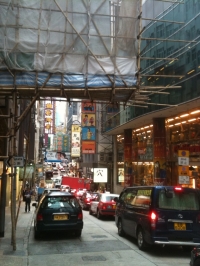
On the busy streets of Hong Kong
In Shanghai I met up with local practitioners too, to complement the “top down” discussion with a grassroots picture from the ground. One of the highlights was to reconnect with Bill Yen, who is doing great at his RMT practice. The practice field is charged with a passion to do, achieve, and redefine… something which is quickly becoming a rarity in our corner of the world.
While elusive at times, “passion” is something at the core of the European innovation challenge. In this sense while I have my own issues with the recent elections in Finland, it has helped inject a moderate measure of passion into our society. Let’s see if we can maintain an upwardly trend on this.
In Hong Kong, I visited the offices of OMA and was generously hosted by David and Betty. We discussed the changing nature of their practice and a continuing shift from designing buildings to redesigning opportunities. Of particular interest is their recent work with the local metro authority, which involves rethinking the idea of efficiency (how could you otherwise improve one of the world’s most efficient subway systems? A task they were asked to do).
My last anecdotes come for the Design in Education conference that I attended while in Hong Kong. Thank you Lorraine Justice and Ken Friedman for leading on this critical issue! While stimulating overall, my take-away from the event was that there is a very, very broad spread on the definition of design and design research within the academe. It made me wonder if one can even draw a boundary on the design community.
But perhaps the leading question conveniently boiled down to yet another number: it costs society on average $500,000 to educate a PhD in Design. How do we define the return-on-investment discussion on that investment?
Some vignettes from these two blurry weeks.
—
It's monday and Carl Mossfeldt of the Tallberg Foundation stops by for a chat at Sitra. Our two organizations have a region and a culture in common, not to mention a lot of overlap in our respective missions, so how can we work together? It starts—like many things—with a long lunch.
By coincidence, later that day Marco travels to Stockholm to share Sitra's work on strategic design with Members of the Swedish Parliament and the design community at an event organized by SVID.
—
Marco and I are in a conference room with Sitra's Energy and Landmarks programmes, spending a couple hours on a session to assess our combined activities that touch on land use issues in Finland. We're doing more and more of this lately. It doesn't feel like facilitation, but I suppose you could call it that. It feels more like being a portfolio manager of ideas. That was Wednesday.
—
Next day same thing, but this time with Sitra's Synergize Finland programme who we are assisting by organizing three studios next month. With about four weeks till the kick off there is a constant buzz of activity. We're revisiting the details that have been confimed for months to make sure they're still supporting the way the plans have evolved. "How much freedom do we have to adjust the space, did you say? Can we put a curtain here to add acoustic isolation?"
This is our first time opening up the operating model of the studio to people outside of our own small team, so it's a good learning experience. The most painful "whys" are the best ones and most important ones to answer—to make explicit. There are alot of "whys," especially around the role of the softer details.
—
Another Monday: I'm standing in front of 30 people in Bilbao explaining Sitra's use of strategic design as a way to match vision, which can be powerfully vague, with intent, which requires more focus and specificity so that it may guide action and decision. I was delighted to be presenting as part of the 'faculty' of the Young Foundation's Global Innovation Academy (GIA) inaugural programme. We also had a chance to do a quick iteration of the network mapping method that HDL initiated last year in our 2010 studios.
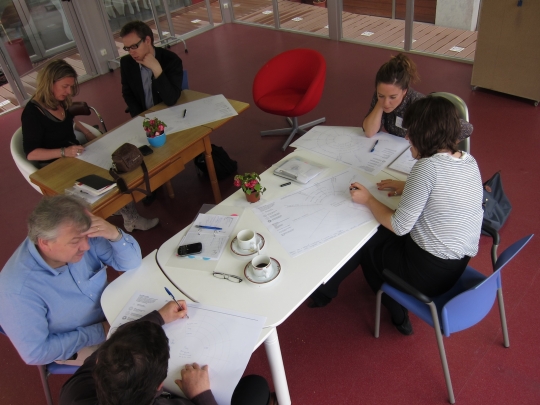
A snapshot from the event in Bilbao
The academy's goal is an important one. If I have to put it into simple words I would say that their challenge is to make social innovation the norm within the public and 3rd sectors. When that happens it will cease to be the buzz-enabled "social innovation" per se and become, more simply, the new definition of good public service. Best of luck to Andrea, Cynthia, Louise, Rob, and the team. We'll be following along!
—
Tuesday: an SMS arrives heralding a successful decision in the Helsinki City council with regards to bicycle lanes around Töölö bay. This came after a breif chat with Martti T. wherein he took it upon himself to visualize the issue using Sketchup, and in doing so change the nature of the debate. We hope to have Martti contribute a guest post on the decision in the near future. Until then we take it as a positive sign that even simple visualizations can have a transformative affect on decisions.
—
Friday. Finally Friday. It's all hands on deck for Sitra's Strategy team and we're huddled around the 14th floor conference room to learn some tips on design ethnography from Ville and Nuppu of WeVolve. This is one small part of the on-going changes at Sitra. It feels good. It feels like an exciting way to end week 108.
It feels a bit like an air traffic control tower in our corner of Sitra-house these days. Between various physical comings and goings, we've also been in the thick of routing projects to and fro.
A big item for us was getting the first 100% text draft of the HDL Studio publication out the door. It was a bit later than we had hoped, so it's nice to have relief from the pressure of being behind schedule. Now that we're receiving feedback from a couple people who have been enlisted to be critical readers it's starting to feel more real. Soon TwoPoints will be doing layouts and then it's truly off. Throttle up.
Marco has been spending his time between Low2No and exploratory meetings for a new (and yet to be named) project. Early feedback is positive but we're still awaiting clearance for take off.
Meanwhile we've been continuing our in-house collaborations as well. In the past month we have really begun to dig into what the Synergize Finland studios will look like. Stuff like securing the studio leads, nailing down key bits of the schedule, and also taking the time to revisit some of the core principles and renew our shared commitment to them. Boarding completed. Requesting clearance to push back from the gate.
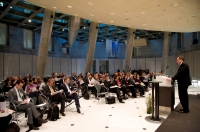
Opening of the SEE conference. Photo by Michael De Lausnay.
On Tuesday I was in Brussels to share Sitra's work with the guests of the SEE Project at their Policy, Innovation, and Design conference. I left the event feeling optimistic that the economic advantages of design+business, the so-called creative economy or ceative industries, is broadly appreciated. Design was also being used in multiple presentations as a way to bring the needs of users back into the center of decision making, particularly in the public sector.
It was nice to see the launch fo the Service Design Toolkit, for instance, because it gives tools to people who might already have the desire to work in a more empathetic way but are struggling to find a structured way to do so.

Outside the Flemish Parliament, venue of the SEE Project Final Conference: Policy, Innovation & Design
The mixed content of the event brought to the fore a point which seems unclear at times, particularly when "design" gets introduced to policy contexts. Does "design policy" focus on increasing the demand for design services in a "policy for (to support) design" sort of way? Or, on the other hand, does "design policy" refer to the use of design methods to deliver new or improved services, systems, or strategies?
The latter we think of as "policy by design" and that's squarely where we put our focus at Sitra through initiatives such as HDL. Both 'policy for design' and 'policy by design' have important roles to play, but being specific about which one is on the table at any given moment helps an audience to evaluate the value proposition of design. Thanks to Mark Vanderbeeken of Experientia for putting together a well-rounded lineup that succinctly crystalized these thoughts. Cleared for landing.
March is a good name for this month. That's what it feels like: a march. Summer is already just around the corner but there's a lot to be done between now and then. These past two weeks have mostly been about sharing.
Sharing with other teams at Sitra, sharing with the world via writing, and sharing with similar organizations who are developing new ways of working on comlex problems.
Marco and I continue to work with the Synergize Finland team as they will be using the Studio model this May. I gave them a brain dump on what a Challenge Briefing is, what role it plays in the studio, and how you structure a similar document. They're off and running on briefings for their studios and it will be cool to see the concept reflected back to us through their experience with it. Marco has been recruiting designers to play the role of studio lead.
During the past two weeks we've also submitted three article for publication on three continents. Two of those discuss the Studio model in greater detail, and the third looks at strategic design vis-a-vis the practice of architecture. We'll post links here when they are available—I believe the first will be the forthcoming issue of Volume Magazine on Ageing.
It feels great to have these deadlines behind us, and I wish I could say that the typing hands can rest now, but no! We soldier on with another big deadline for a draft due in the middle of March. This one is a self-imposed deadline to more thoroughly document the Studio model and our three studios last summer.
On the topic of studios, we caught this interview with John Seely Brown on the radio in Australia (mp3 link):
"In a world of constant change, [design is] the ability to imagine, the ability to take close assessments of where you are versus where you want to be, and figure out how to move from here to there. Design was a nice thing to have in the last few hundred years in a world of stability, but really the form of productive inquiry underlying design is now critical in a world of constant change.
Basically we're living in a world now where our skills have about a 5 year half life. when I started out doing stuff it was a 30 year half-life, so today we have to be at any age able to pick up brand new skills... The studio is one of the most concrete ways of working with the real, working with the concrete, letting the imagination fly, and then collectively with folks around you and mentors actually produce new knowledge."
We were out and about too. I gave a talk to Aalto University's Creative Sustainability course. Marco was in London to participate in the Ecobuild conference and share some of our experiences with Low2No. Afterwards he and I spent a morning catching up up with Nick Mabey at the HQ of E3G. They've just published Degrees of Risk which I haven't had time to read, but knowing Nick and his team it's should be thorough and insightful.
Degrees of Risk is the output of a multi-year process working with climate scientists and security experts to flesh out a framework for moving to a risk management approach to climate change, in contrast to the singular focus on migitiation. Doing so implicates a much wider array of decision-makers, from security to infrastructure, each with established ways to plan for future risk. The framework is an intensely clever way for hacking the climate debate to put it into terms that a larger group of people—everyone—gets: risk.
And now for an abrupt transition: from climate risk to sea ice. Under an unusually bright Sunday sky, I went for a walk on the sea ice last weekend to do a bit of research on Helsinki food culture.
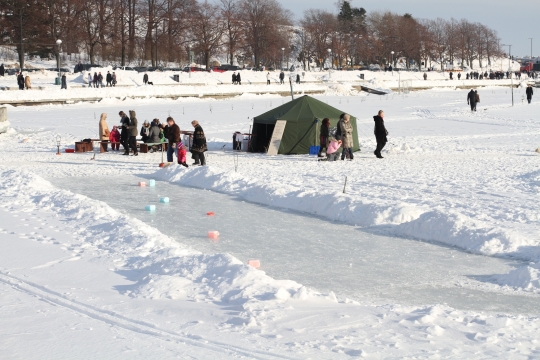
Temporary cafe set up on the ice... and curling sheet!
One of the delightful things about northern cities is the degree to which their geography changes during winter. Helsinki comes alive with recreational opportunities all across the frozen sea. Suddenly the isolated boat gas station becomes a winter cafe, with a new arrival path across the iced-over harbor. Remote coffee shops have new streams of guests who come to roast sausages on outdoor fire pits. Or have a curling match. This won't last for too much longer, given the warm weather we've been having, so I'll have to wait for next year to corral my colleagues into starting the Sitra Curling team.
Week 102 closes with a steady hum—and the clickety clack of more writing.
We're back from a week (#96) in Umeå, Sweden, home to the Umeå Institute of Design, and location of a courageous experiment in Prototyping the Future. Anna Valtonen, HDL Global 2010 participant and Rector of the school, decided to shut the place down for a week to pause and consider what the future of the design school may be. All students, staff, and even Anna herself put aside their course work to participate in special workshops taught by guest faculty. Marco, Justin, and myself brought the HDL Studio model to Umeå as an example of how designers might begin to play more strategic roles, especially in service to government.

Västerbotten is about the same size as Denmark but has only 1/16th the population.
To demonstrate this concept we teamed up with the county government of Västerbotten, the second largest county in Sweden and administrative region that includes the city of Umeå. Governor Chris Heister and Deputy Governor Birgitta Heijer issued a challenge: How can we make Västerbotten more attractive so that it attracts new residents and retains existing ones?
We asked the students to develop ways to rethink traditionally difficult aspects like the far northern location of Västerbotten as assets that could be utilized to develop a new vision for the county. Governor Heister described the unofficial slogan of the county as "In Västerbotten we have it all" which the studio flipped around to be "In Västerbotten you can have it all!" This highlights the county as a place of opportunity that benefits from diverse natural environments, geographies, urban densities, and lifestyles, where it's easy and comparatively cheap to take root.
The Governor issued the challenge, Sitra brought the HDL Studio model and played the role of facilitator, and UID students did the hard work. It was a hectic week, but a good one. We certainly learned a lot about what makes a studio tick and this is invaluable knowledge as we continue to hone the HDL Studio model.
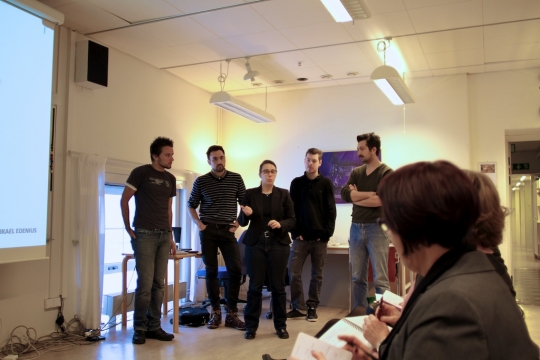
A snapshot from the final presentation
The students had a tall order ahead of them. With only five days to deliver they had to dive into new territories such as economics, public policy, and demographics; make sense of this tangled mess of perspectives; and propose a framework for developing a course of action for the county.
The presentation went well and sparked a lively discussion with the Governor and her guests. While the students are gathering up their presentation material I'll leave you with a cliff hanger, but as soon as the files materialize we'll prepare a dossier of the week. In the meantime, there are a pile of pictures up on Flickr.

The studio with Governor Heister and her guests
Week 95 was spent in London catching up with some other HDL Global 2010 participants in between meetings related to other Sitra business. It was especially great to catch up with Indy Johar of Research 00 Architecture as well as our friends at the Young Foundation.
Helsinki is under a heavy blanket of snow which has added a lovely bit of chaos to the streets. We're happy to accept the occasionally frightening skid-stop of a lumbering bus if the weather also brings with it amplified levels of daylight reflecting off the ground cover.
Last week Marco was in Brussels sharing HDL's work at the Design and Learning conference. I was away in Madrid doing the same with a group of innovation researchers sponsored by the Spanish National Research Council. The participants were a mix of academic and professionals which resulted in some productive friction as we adjusted to the language and concerns of our peers. I was particularly interested in Steve Flowers' work on defining different categories of user-led innovation. So often this term is treated as a homogenous lump of stuff, but Flowers breaks it down into five different levels of involvement that scale up in their innovation potential.
- Users provide feedback
- Users produce content for existing products
- Novel use of existing products
- Modification of existing products
- Creation of novel products
As he pointed out, not all user innovation is bound for the market. Sometimes (a lot of the time?) innovation, user-led or not, produces weird results. Such as a disused MiG mounted on a train used to clear snow off of train tracks.

Image borrowed from this collection of truck-mounted jet engines.
Drew Hemment shared his work on the FutureEverything festival which he sees as a vehicle for social innovation. The broad range of activities they're conducting is too much to go into here but it includes bubble races (PDF) used to measure urban heat island affects. Drew gave us a peek at an almanac of sorts which FutureEverything is now working on to share their methods with others looking to do something similar. It's encouraging to see such an open sharing of experience. We try to do the same thing with our How-Tos.
Meanwhile, Justin was in Germany with part of the Low2No team. He's been keeping weeknotes over at the Low2No site and I highly recommend reading them for the full scoop on how that project is coming along.
I'll close this update with a hearty congratulations to the SIX Social Innovation Exchange for their successful bid to create and EC-sponsored Social Innovation Initiative for Europe. HDL is happy to be part of the advisory board for this project and we look forward to being part of it.
That restfulness I wrote about last week? Yeah, that's gone. Week 083 started with an adventure. We climbed to the tip top of our building to get a good view of Jätkäsaari to take some photographs for Low2No.
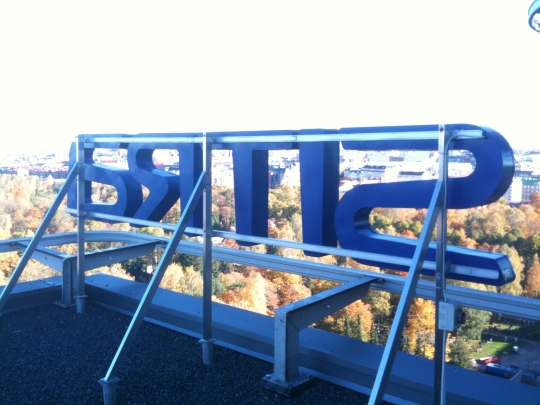
The "17th floor" (we only have 16 floors in our building)
Marcus Foth from the Queensland University of Technology was in town for a conference and dropped by to chat about urban informatics. They're working on some interesting applications of ubicomp relating to sustainability issues such as food and energy.
Marco is in Belfast sharing Sitra's work with a university there and savoring the last days of his holiday. Meanwhile, Justin is holding down the fort in our Boston office and I hopped over to Copenhagen for a day to catch up with INDEX and MindLab.
Liza (HDL Global 2010) and Niels at INDEX were gracious enough to host me for a morning of case study research. We're looking for another round of case study candidates. If you have any suggestions, please drop us a line! Through years of offering the design award, as well as student design challenges, INDEX has a wealth of knowledge about design projects around the world.
I also stopped by COBE, an architecture office that increasingly finds themselves working at the intersection of traditional architecture and strategy. Their Taastrup Theatre renovation/expansion project is nice example. Asked to renovate a concrete box of a theatre, the team engaged the local public through co-creation workshops to develop a shared vision. This led to an expanded brief and a new budget that enabled a stunning piece of architecture.
Next up was Mind Lab, where Christian (HDL Global 2010) shared his wealth of knowledge working as a design-oriented organization embedded within government. Spanning three ministries, Mind Lab is a really unique organization that combines anthropology, policy, and design knowledge to improve government services. Christian's new book Leading Public Sector Innovation: Co-Creating for a Better Society might be of interest to readers of this site. One of the simple pleasures of life is a meeting with no agenda, and that's what Christian and I had: a free-ranging discussion that covering many topics. As we think about the future of HDL and the role of design at Sitra, these kind of chats are very important.
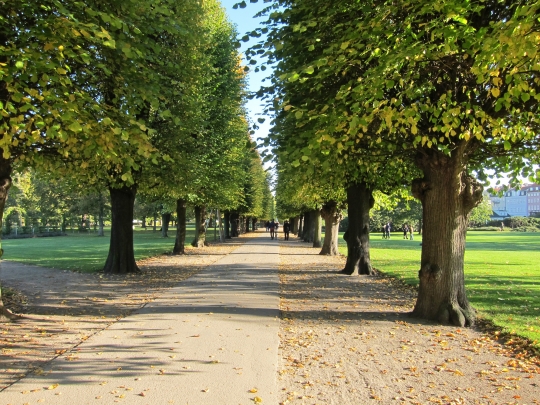
A walk through Copenhagen's Rosenborg castle gardens
It has been a great week for reflection. This morning we had a visit from Geoff Mulgan of the Young Foundation whose SIX Spring School we enjoyed exactly 20 weeks ago. Like Mind Lab, The Young Foundation are among some of the most interesting do-ers we know so it was a great coincidence that Geoff was in town and had time to stop by. He and his team are doing some work to clarify the various roles, skills, and tools in design projects. When this is published I will make sure to link to it here. Good stuff.
And in other news, it snowed in Helsinki last night.
Summer is in full swing here in Helsinki, which means that things are slow. Well, things are slow everywhere but HDL. Marco and I continue to narrow in on HDL Global, taking advantage of the empty calm of the office to talk through some scenarios without having to slice the conversation into between-meeting-sized chunks.
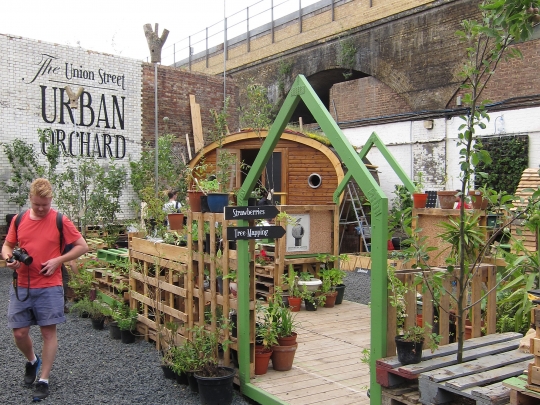
A temporary fruit orchard built in the heart of London as temporary nursery for plants and trees which will ultimately be gifted to local schools and community groups. Also home to Aalto University's Nest, sponsored by the Finnish Institute.
I started the week in London, where I was visiting the London Festival of Architecture to share some thoughts about design, complexity, and decision making informed by our work here at HDL.
Back in Helsinki we have things on the burner: working with XOXCO on a new part of this website, which will be helpful for sharing the work of the HDL Studios as well as supporting Studio-style work in the future; walking through HDL Global step by step with Emil+Stephanie to make sure that signage and printed material is designed for all of the needs, navigational, informational and otherwise; setting up contracts and schedule for some video work to kick off in early August; on the horn with Zurich to explore a potential new avenue for HDL.
We also put up a ton of images on Flickr. Over the next week we'll trickle some of those photos on the blog, but if you just can't wait to see you can find shots from all of our HDL Studios, most of which are by the talented Ivo Corda.
This update comes from somewhere over the middle west of the United States, as I type away thanks to inflight wifi. Marco, Justin, and I have been in San Francisco for the Design Management Institute's Re-Thinking the Future of Design conference. Largely focused on the effectiveness of an expanded use of design within commercial organizations, Marco was sharing our work on a panel with Kyung-Won Chung from the Mayor's office in Seoul, South Korea, as well as Bruce Nussbaum, Roger Martin, and Jeanne Liedtka that discussed design in a larger societal context.
The event had a pretty good Twitter feed going and there were lots of lively discussions. The crowd skewed towards a more experienced, and thus older, level of individuals but it was nice to see some young faces in the audience as well. My eyes are especially attuned to these kind of demographics when I visit events these days.
With the HDL Studios and now HDL Global we've made a conscious effort to make space for younger voices in the conversation. Not only is the youthful perspective important, but we want to create opportunities to expose them to a new way of working and a new set of tools while they have an entire career ahead of them.
Speaking of students, this week concludes the work of Anna-Leena and Christina who have been supporting the ageing studio. Rather than work part time for a month, they compressed their work into a focused week-long charrette, which might explain the "brain self portraits" they drew.
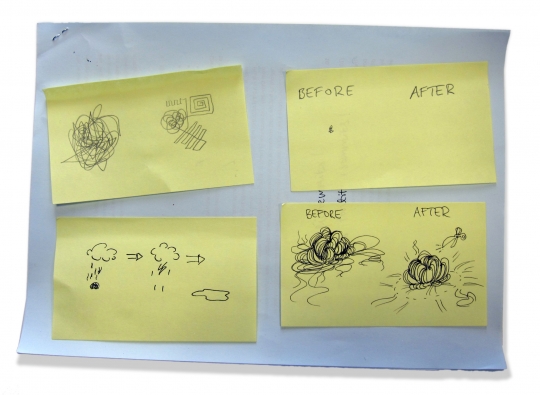
Not sure what this says about HDL, but it's a fun exercise to draw a brain self portrait. Give it a try!
While in San Francisco, Justin and Marco managed to sneak in a couple Low2No working sessions with Arup and I paid a visit to Adaptive Path, where I had a chat with Peter Merholz about his growing design consultancy, and global design practice in general.
It was a good week and now we begin our laser focus on getting ready for September.
Yesterday was a whirlwind tour of Jyväskylä, which we visited to see a cross section of how one city thinks about its elders.
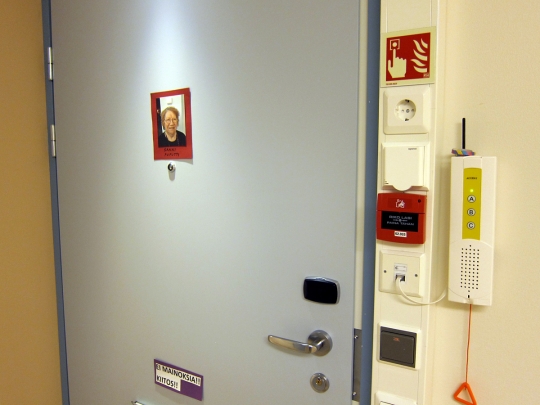
The balance between the human and infrastructural/institutional presence at an individual's front door inside an assisted living facility... interesting.
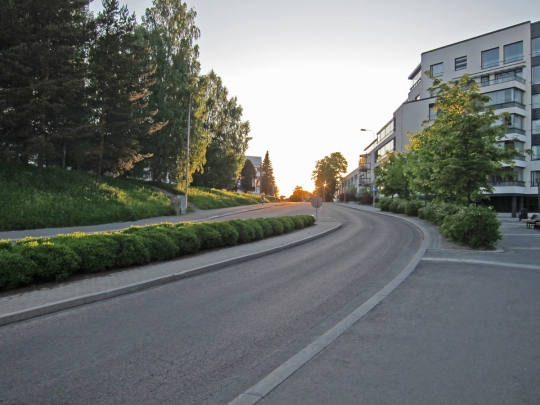
What it looks like at 11pm in the summer when you're at 62° north.
This post continues the story of Seungho’s trip to Cambodia with Aalto University. Read the first part if you want to catch up...
So here we were, nine of us from five different countries seeing Cambodia for the first time. Seeing and living were very different from reading, watching and listening in comfortable homes and lecture halls. Things taken for granted at home were not easily achievable here: clean water, sanitation, sewage management, waste management and education, just to name a few.
We were lucky to have people with many different backgrounds: industrial and strategic design, architecture, urban planning and landscape architecture, which enabled each of us to focus on a few topics to develop deep insight so that we could help others see problems from various perspectives while working in teams. Nightly briefings kept everyone clued in and these discussions were very fertile. We were also lucky to have students from different parts of the world in the course, as well as working with Cambodian students during our stay, which made the whole visit fluent and fruitful. Soon we’ll return to Helsinki and form groups with those who did not travel, expanding the diverse set of perspectives even more.
We are free to choose a site for our studio projects. Among the most terrible of the relocation sites was Trapieng Krasang, where the urban poor from four different places were involuntarily relocated to some 20kms outside the city and they now struggle to survive. This is a population of Tuk-Tuk drivers, Moto-Dub drivers, bakers, street fruit vendors, waiters and waitresses who have been relocated away from their jobs and now have no income. One lady, for example, makes two and a half dollars a day if she goes to the city to sell vegetables. However, it costs two dollars to get to the city! The relocated families were each given nothing but a 5 by 12 meter plot on a former rice field. The earth is fertile there, but the plot is far too small to be the source of living, let alone the money to build a shelter.
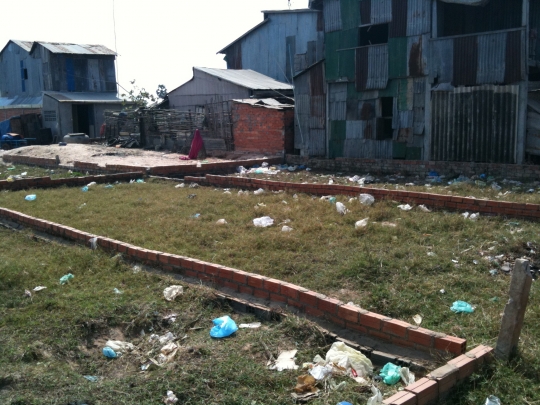
Empty plots in Trapieng Krasang. Many of the evicted families sold the plots for very cheap price and headed back to the city slums due to the lack of job opportunity. Sold plots have become the subject of speculation, which will make the rich richer.
This is compounded by the issue of unclear entitlements, which dates back to the Khmer Rouge regime when many citizens were herded out of the city. One third were killed and many of the survivors never returned. Eventually, those who did return to the city settled wherever they could – with whatever means they could. A few decades later, the Cambodian government, challenged with deep-rooted corruption, is selling the prime locations of Phnom Penh city to private investors who are taking advantage of murky land ownership status.
Development in the city of Phnom Penh is another significant problem. Two years back, a private investor bought the Boeung Kak Lake area which is about 1 square kilometer and began filling in the lake to build a hotel and resort. People near the lake have been forcibly relocated and a large fire during our stay in Phnom Penh cost hundreds of families their homes in a single night. Now Boeung Kak Lake is as small as one third and soon will be 10 per cent of its original size. As summer brings monsoon season we will see the impact of the such radical environmental changes. Recently the Royal University of Fine Art as well as the National Museum have been sold to a private investor and the students are under threat of eviction.
![Boeung Kak lake as of March 2010.
Photo credit: Save Boeung Kak Campaign [http://saveboeungkak.wordpress.com]](../../peoplepods/files/images/383.540.jpg)
Boeung Kak lake as of March 2010.
Photo credit: Save Boeung Kak Campaign [http://saveboeungkak.wordpress.com]
Some can say that development in Phnom Penh is giving jobs to construction workers, hopefully boosting the economy, and making the city a better place to live in the end. However, the number of the people evicted from the city is much higher than the number of workers hired. Does development have to be at the expense of so many homes, jobs, and lives lost?
The economy of urban poor in Phnom Penh is shallow and fragile: many of their livelihoods are very much dependent on tourism, a competitive industry with significant competition from nearby Bangkok. Cambodia imports many things, including foodstuffs, from Thailand and Vietnam, thus making commodities expensive. The shift from agrarian to industrial society, then an industrial, and on to a service and knowledge-based economy appears to be a long journey for Cambodia.
City in Crisis course does not pretend that problems of this nature can be mitigated immediately. Rather, it aims to have us students aware of and ready for the real problems of architecture and design for a longer term.
Back in Helsinki, we’re focusing on five different projects: a master plan including urban farming solutions for the relocation sites, in particular Trapieng Krasang as a case study; a “sub-center” concept for relocation sites, which brings markets and basic facilities to the area; the rehabilitation of remaining lake areas south of Phnom Penh, with specific attention to management of sewage flow; disaster management for slum inhabitants; and finally mine, a strategic road map and a framework for the economical development of the urban poor of Cambodia.
My question started from the living condition of Trapieng Krasang but my interest has soon extended to the economy of urban poor and the mindset: what does a pathway to economic stability look like for the relocated families of Trapieng Krasang?
I’m Seungho Lee, a Masters student at Aalto University School of Art and Design, studying in Industrial and Strategic Design and currently working with Helsinki Design Lab as an intern. My studies have taken me to Cambodia, where Aalto University's City in Crisis course is expanding the design discourse to include history, corruption, land entitlement, education, political enfranchisement, economics and more. This post was written a while ago, and it's part one of three covering my studies in the City in Crisis course.
As I type this, I’m 8000km away from home, waiting for a return flight from Phnom Penh, Cambodia back to Helsinki. I’ve been here for two weeks with nine of my fellow students as part of the City in Crisis course. Although I came to the airport three and a half hours early, I don’t mind because I wanted to escape from the city: there’s been a lot to digest after two quick weeks of fieldwork.
During that time we’ve been visiting Angkor Wat, the floating village near Siem Reap, Silk Island, a few slum areas and few eviction sites in Phnom Penh as well as relocation sites where those evicted now struggle to survive. We've also met and learned from representatives from various NGOs: STT, OPC, UN Habitat to name a few. Corruption, lack of secure tenure, almost no industry, false development, lack of education, slavery… this is the reality for many of Cambodia’s urban poor.
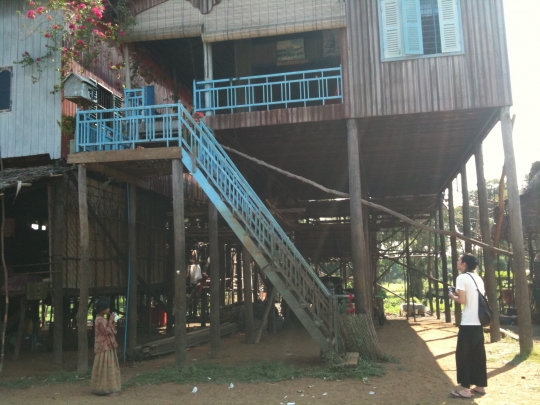
Floating village, a vernacular principle in Cambodia where the rainy season continues for six months.
Architects in the wealthy parts of the world have a tendency of being primarily interested in what their more successful counterparts in other wealthy parts of the world are busy with. The professional magazines in Europe, North America and the rich parts of Asia are concentrating on the “wow-factor” and its various manifestations. It is far less common that these publications deal with the everyday problems of the majority of the world’s problem.
– Hennu Kjisik, Veikko Vasko, & Hunphrey Kalanje. The Final Report of City in Crisis, May 2009
This phenomena is evident in recently published Phaidon Atlas of Contemporary Architecture that introduces 16 Finnish projects among 588 European projects, but only 26 projects from whole Africa and 184 projects from Asia. As pointed out by Hunphrey Kalanje, one of teachers of the course, architecture is in many cases political: it works with capital, for capital, and by capital.
The City in Crisis course has been offered since 1993 by the department of architecture in Aalto University School of Science and Technology with an aim of strengthening the global awareness and social conscience of its students, as well as increasing our understanding of the realities of life and conditions of professional work in developing countries.
Since these things are notoriously difficult to be taught in lecture halls and studios, the annual fieldwork period has become an essential part of the teaching and learning process since the beginning. After a total of ten years in Africa - Rusfisque, Benin and Grand Popo in particular - City in Crisis has turned its eyes to the east, and the first group of students traveled to Cambodia at the end of February 2008.

Some of my fellow students in the heart of Angkor Wat. One can easily imagine how glorious the Khmer civilization once had been.
The course is designed in two parts: the first of which aims to acquaint its students with various development issues all over the world and local vernacular principles. During the autumn semester in 2009, we read about and studied about four themes: development discourse, global issues, urban agendas, and construction in developing economies, which was followed by research into the vernacular principles of indigenous architecture in different climates.
The second part consists of lectures and seminars dedicated to issues in Cambodia, the fieldwork to Phnom Penh and Siem Reap and eventually the studio work back in Helsinki. From January of this year invited lecturers have talked about issues in relation with water, development, corruption, environmental issues, capital, and speculation in Phnom Penh.
After studying these issues from a range of scales, both from the global to the local in Cambodia, and from the past to the present we packed our bags for two weeks in Cambodia. It was time to see and to “live” the reality.
Check in tomorrow for more about our time in Cambodia.
Ambiguous Middle Phase continues but now with some glimmering of what lays ahead, beyond this chaotic period for HDL.
The week was bookended by a laundry list of activities related to the three Studios we're planning for summer: visiting a possible space right next to Delicato; interviewing students to join the team in supporting research roles; confirming studio members; interviewing two top talents experts on ageing; hunting down a map of internal migrations; and checking in with Gaia, who are preparing some futures projections. That's the sort of stuff that is continually churning, but I'm making note of it here so that we can look back in a couple months and remind ourselves of the rich crucible of everyday chores that created a background for deeper considerations about HDL.
On Tuesday Marco, Minna, and I took a day trip to Copenhagen to meet the fine people at MindLab and INDEX. Established as a design facility by three ministries (Employment, Taxation, Economic & Business Affairs), MindLab is one of the very few examples that we know of where design capability is explicitly integrated into government activities. They're been working to help government bodies improve the services they offer to the citizens of Denmark with a mix of design, social science, and public policy expertise.
After a very good and very hurried lunch we met with Kigge and Liza at INDEX:, the world's largest design award. It's set up as something along the lines of a Pritzker or Nobel for socially-beneficial "design to improve life." Naturally this high ambition for the contribution of design is something that we very much share. As is the recognition that to foster the ability of designers around the world to make a larger impact means very literally supporting them, enabling them to work without immediate clients. Or even markets. In particular it was nice to hear a bit about where their thinking is headed in the future. We're sworn to secrecy though, so stay tuned!
It's great to find allies – more and more of them every day. Not so long ago, if you said that you're interested in design with a social motivation and a practical imperative, you would have found very few people to share those aspirations with. Both of these discussions in Copenhagen underscored the fact that not only is this broader definition of design becoming a simple fact of the word's definition, but that there are more and more groups developing keen insights into implementation. What are the barriers to delivering improvements? How do we rethink the structure of design practice to open new opportunities? Who can designers involve in their work to benefit from expanded expertise on making things happen?
This is exciting to us because the design community is finally beginning to answer 50 year old questions. We're making those visionary "what ifs" from the 1960s into "why nots" – and "why not" is a much more operable question.
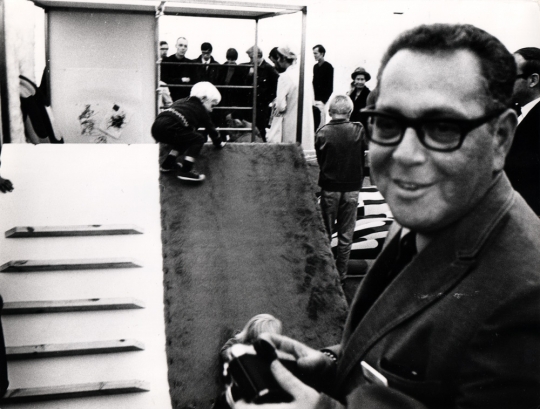
Victor Papanek in front of a prototype learning environment for children at HDL 1968. Photo by Kristian Runeberg.
With my laptop battery dying, I'll close with a quotation from HDL 1968 by Victor Papanek, the father of green design. It's unusual to see him praise the consumer products industry, but here his message is more about bootstrapping than cars. Replace "industrial designer" with "strategic designer" and this quote pretty much sums up the transition we're experiencing right now, as design is increasingly integrated as a core competency in governmental-scale problem solving.
If we go back to the history of the design profession we find that it started in the late twenties... around 1927, 1928, 1929 is when industrial design began in the United States.
It started by someone saying "I am an industrial designer." And then going around to radio companies, to electric companies, to truck people and so forth saying "I am an industrial designer, and I can do this and this and this and this."
And the companies were sometimes impressed and hired this man, be he Raymond Loewy or anybody else, and the same people are still working for the same companies.
Suomenlinna, Helsinki. July 17, 1968.
We agree with Victor: it takes a daring few to open new areas of opportunity!
Hello from Singapore! The big news is that Helsinki has officially won World Design Capital status for 2012 with its Open Helsinki proposal. We've been chatting with Pekka Timonen off and on as he lead the bid team and it's a real pleasure to congratulate him and everyone on their fantastic work. So while we still have our eyes set on 2010, start marking 2012 on your calendar too.
In honor of the win, the last day of ICSID World Design Congress saw a bit of a Finnish invasion with The mayors of Helsinki and Espoo as well as representatives from the Foreign Ministry, Helsinki Design Week, the Design Forum, Taik, and Marco and I representing Sitra and HDL. Yrjö Sotamaa was so excited he ran around the congress hall with the World Design Capital flag trailing him like a cape.
The format of the congress was interesting for us to see since it has some resonance with how we're preparing HDL 2010. A series of "studios" were organized in the year prior to this week, each with the task of envisioning life in 2050 as it relates to a number of focus areas ranging from agriculture to entertainment. The studio heads took widely different approaches to their work. Some seemed to really get into the format and developed research seminars around their efforts, others seemed to have simply added a few new slides to their default presentation decks. Some presented plausible scenarios rigorously argued and supported with well-cited evidence, others relied more on the whims of the presenter to sketch out a possible future. The degree to which foresight work delivered by foresight experts dominated the two days of conversation that I attended highlighted the extent to which design practice has been focused on current day and immediate-future realities. Designers generally aren't in the habit of proposing floating-car futures any more, are they? Is this good, bad, or gray?
The congress reminded me of Jim Dator's Four Generic Images of the Future, a useful framework that Stuart Candy introduced to me at the University of Hawaii back in March. Stuart underlined a simple fact: if we're not in the habit of imagining the future we have a much harder time manifesting a desirable one. The work that Stuart and his colleagues are doing is essential and seems like ripe territory for collaboration with designers. Thinking about the future gets at ethics in a novel way: if you can imagine anything, why are you imagining this specific thing?
The ethics of design practice was a recurring theme both here in Singapore and last weekend in Torquay. If designers become more involved in projects with a broader social impact – and particularly if they begin to find themselves at the table of political decision makers – the stakes of our work become very high. Personally, I believe that conscientious, talented people generally rise to the challenges they are given and there's nothing better to prove your mettle than to have it tested. Still, I'd like to see the conversation about ethics of design move to a more nuanced level.
The work of groups like Architecture For Humanity is fantastic, but doing pro-bono projects for under-served populations is not the only option for ethical practice. A binary argument between good and evil design practices may do more harm than good by allowing lines to be drawn and sides to be taken that are almost religious in their fervor. In that sense, what I'm lamenting is the lack of ethical debate about how and why we conduct our work rather than ethical judgment.
The conversation took an unexpected turn in Singapore when Chris Bangle and a few others speakers argued that the congress was filled with too much doom and gloom. "You can't push someone to make significant changes in their life," Chris argued, "you have to pull them." In other words, we need to find ways to seduce the planet to live sustainably rather than guilting them into it. Probably need a bit of both, don't you think?

A view over Singapore's developing waterfront snapped in between conference sessions.
Together with the Idea Factory we hosted an HDL dinner with some fantastically interesting people for all over Singapore. Ban Y J – the bon vivant, designer, and entrepreneur behind Stikfas – emphatically spoke about the need help designers break through the "surface tension" between being a garage start up and a viable market entity. In his words, marketing is the key to "raising a hand up and being seen." Particularly in countries with small home markets like Finland and Singapore, breaking through that barrier is critical for long term success. But perhaps even social issues need the right marketing campaign to give them the appropriate chance to survive in this crowded world. Responding to Joanne Yap's introduction of Jurong General Hospital's move from "an illness focus to a wellness focus," Ban asked how you entice people towards wellness? One key strategy is persistent and open community engagement, something Jurong has already started: how many hospitals exist on Facebook before they are entities in the real world?
